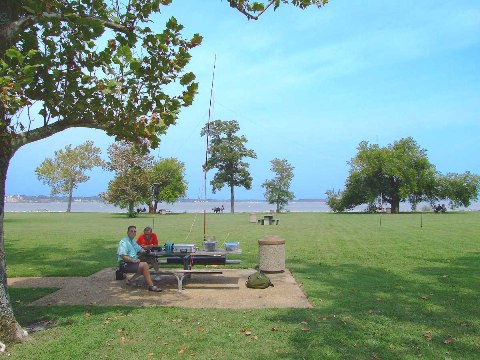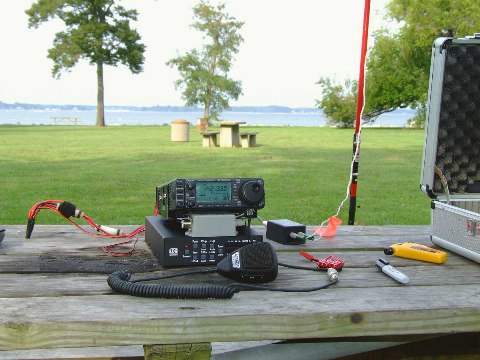Had a nice 80M CW QSO last night with Tony, KN4VL. There was some QSB and QRM, but we hung in there for about an hour ragchew. Tony is a retired Marine and has children and grandchildren in the armed services. I think I’m slowly making progress on the CW front.
Yesterday after work I wanted to swap out the feedline on the Carolina Windom from RG-58 to RG-8X. My plan was to lower the matching unit which has an eyelet on top that I used to raise the matching unit up to ~50ft with some heavy duty line.

I loosened the line and attempted to lower the matching unit, but the line was getting hung up in the tree branches above. I let the end of the line go and began to gently pull on the RG-58 feedline to slowly bring the matching unit down to a point where I could reach the line isolator (hanging 22′ below the matching unit) so I could swap feedlines. I got the line isolator down to my level and successfully swapped the feedlines. I then went to grab the end of the line to pull the matching unit back into the treetops, but it wasn’t there! Then I looked up. The line had been shorter than I thought – when I had pulled the matching unit down using the feedline, I had not realized that the line was so short and now the end was dangling a good 15′ above my head! I got out my ladder to try and reach the line but it wasn’t tall enough. I then tried standing on the latter with a rake, in an attempt to snag the line and pull it down. No luck. I had an idea. I grabbed one of the 10′ PVC pipes that I use for my G5RV during a
portable setup to support the ends. The top of the pipe has a hole drilled through. I then grabbed about 20′ of small gauge wire, threaded a loop through the hole at the top of the pipe and then took the pole back out to the dangling line up in the air. I was able to get the end of the line through the loop, then pulled the ends of the small gauge wire tight, grabbing the line. I pulled the pipe down and the line came with it. I felt pretty stupid, but I was able to get the Carolina Windom pulled back up (now with the new feedline) and my station is up and operational.
While I think the new feedline has helped improve my signal a bit, I’m still having problems on 17M, 15M, and 12M. 17M I’ve always had issues with and from what I read, it might be an issue with the radio itself. I’m usually able to work PSK31 and Phone on 17M without the tuner, but when I dip down in the CW portion the SWR is much too high. Both 15M and 12M will not tune. Also the SWR is too high to use without the tuner. On my inverted vee, both 15M and 12M are usable. So – I know I will need to play around a bit to get everything working.
This weekend is the 2006 CQ WW DX Contest (Phone). I want to use the contest as an opportunity to complete my initial DXCC requirements. The Carolina Windom is good to go for 80M, 40M, and 20M – so I should have plenty of opportunity to work those DX stations.
At lunch today I was tuning around 20M, 17M, and 15M – lots of activity…. lots of stations testing equipment in preparation for the contest.
I need to do two things before the contest kicks off:
(1) fix the power cable to the radio. When I did some shack clean up, I moved all the equipment onto a new Alinco DM-330MVT power supply using the RigRunner. But I was having some problems with the adapter that goes on the back of the IC-706. I need to pull the power cable off, recheck the PowerPole connectors, and the four pins that connect to the IC-706.
(2) setup the ICOM CT-17 so I can save little time by having my frequency automatically saved when I log QSOs on the computer.
…. the question is – can I get both of those done before the 2000 (local) kickoff of the contest?




 Spent some time today reworking the shack…. still have a bit more to do.
Spent some time today reworking the shack…. still have a bit more to do. I jumped on the radio real quick last night before bed. After jumping around from 30M to 40M to 80M, I got an answer to my CQ from Tim,
I jumped on the radio real quick last night before bed. After jumping around from 30M to 40M to 80M, I got an answer to my CQ from Tim,  Went up to the
Went up to the 

 I had a good time. Putting together the Amateur Radio Station In a Box (
I had a good time. Putting together the Amateur Radio Station In a Box (